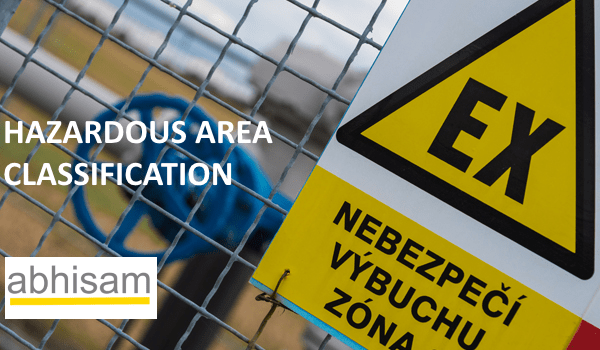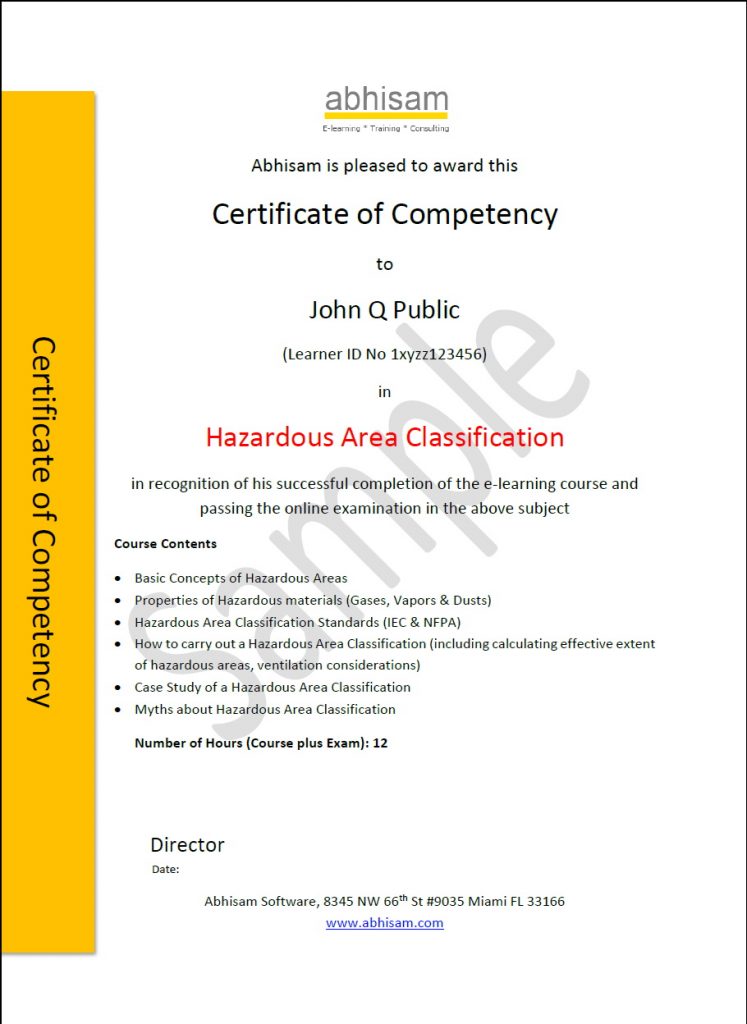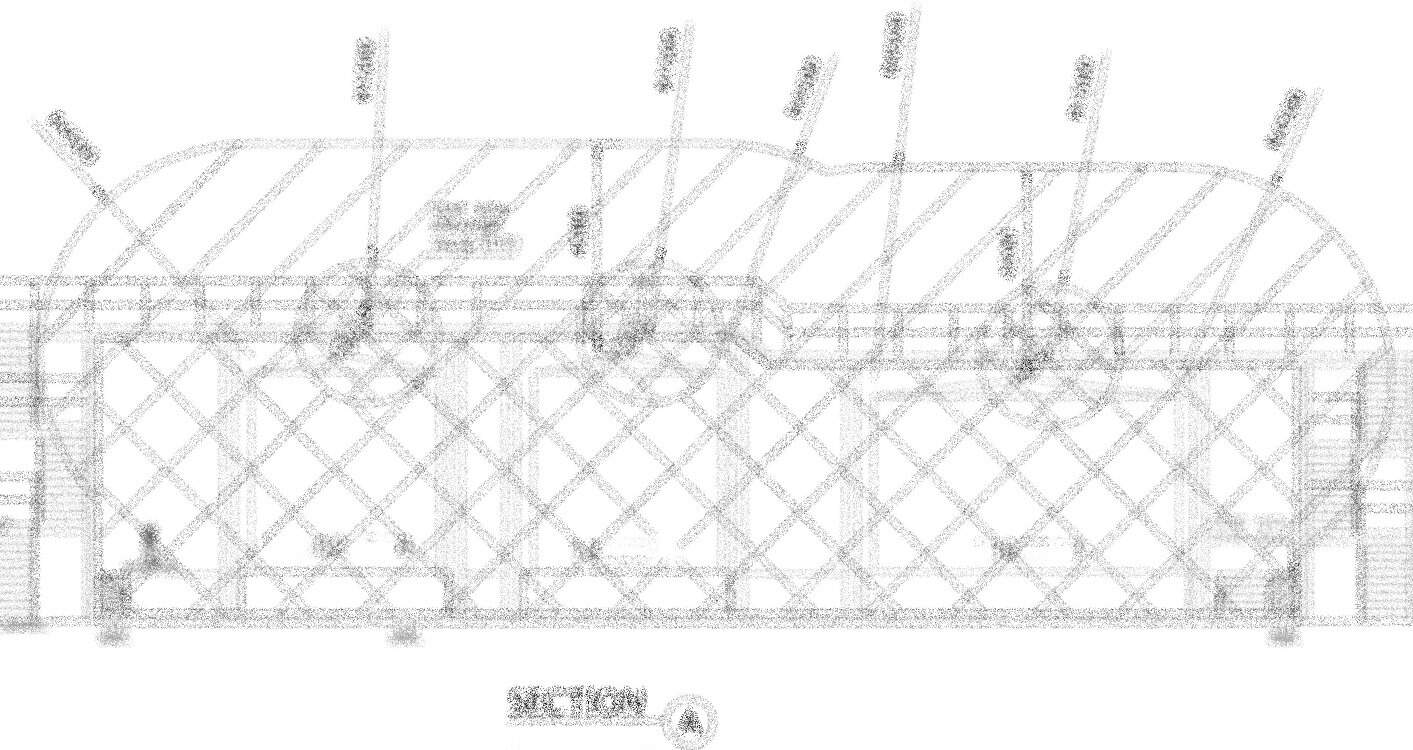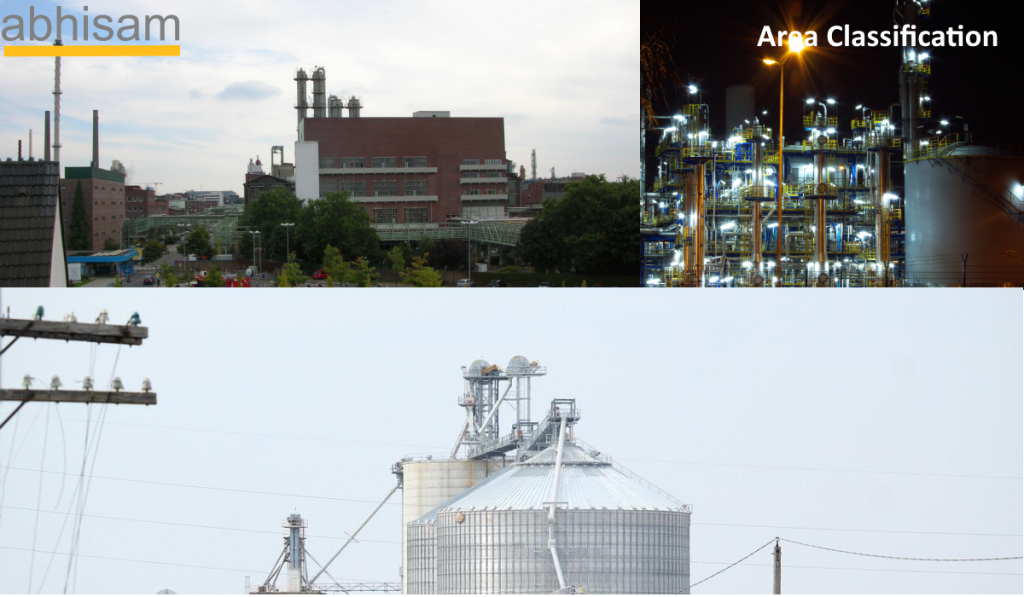Hazardous Area Classification | Training & Certification
Learn how to carry out hazardous area classification using IEC standards as well as NFPA standards. The course includes understanding the concepts of Zones in IEC (Divisions in NFPA), calculating the extent of the hazardous area, accounting for ventilation and preparing hazardous area classification drawings.
Get Certified when you pass the associated exam.

This is the only Hazardous Area course that walks you through all aspects of classifying hazardous areas, using both European/IEC system having Zones and the American/ NFPA system using Divisions. Learn all about determining the extent of the hazardous area, how to identify Zone 0,1 and 2 for vapors/gases and Zone 20,21 and 22 for dusts, how to carry out an area classification for a facility.
Learn from a real life case study to determine the extent of a hazardous area and mark it on the area classification drawing.
Key Benefits of the Course
- Self Paced Course, learn at your own speed, whenever you wish.
- Worked examples and calculations to determine the extent of hazardous areas & ventilation considerations.
- Learn from home, office or anywhere else.
- Access from any device PC/laptop/Mac/Tablet-no restrictions.
- Includes Online Exam and Certification.
- Prove your competency by displaying your electronic badge online on social media.
- Full fledged e-learning course- Its not a video of a guy speaking or a pdf or a PPT.
Engineers and Managers from marquee companies around the globe have taken Abhisam Hazardous Area training courses. Below is a small sample.





Get Certified as a Hazardous Area Classification Professional! Earn an electronic badge that you can display online.


“I have worked in the International Oil and Gas Industry as a technical instructor for more than thirty years. I have both used and recommended the products of Abhisam. I recommend them highly to all engineers and technicians in our industry. No praise is too great!!
John Longden
GCGI LCGI. Senior Trainer
Petroleum Training Institute, UK“
Get real world experience of seeing drawings that have been actually used in area classification projects. The Case Study covers an actual project and these drawings are from that project. The course will have the unblurred drawings.
Easily understand how the extent of Hazardous Areas can be determined via calculations. Note that this is one of the steps that has been illustrated and not the final step of determining the extent.
The included self assessment test enables you to understand your own level of knowledge about the topic and helps in preparing for the Certification exam.
Here’s a sample question from the test.
Real Life Case Study Included
A real life case study of a Hazardous Area Classification project is included. It will have
- Introduction of the project-video
- Study of the Layout drawings
- Selection of the standard (IEC or NFPA) to be used (Zone or Division)
- Determination of the extent of the hazardous area
- Marking of hazardous areas on the drawing.
Choose from any of the versions.
Scroll below to see complete contents.
Standard
For one learner-
Course Duration: 12 hours of self paced learning (Earn 12 PDH)
-
Access the course online 24/7 via any device for one year
-
Exam & Certification for one learner
-
Lifelong Valid Certificate
Professional
For one learner-
Everything in Standard plus
-
Access the course online for 3 years
Get Access to all Abhisam Trial courses, including this Hazardous Area Classification course for $7. You will NOT be billed automatically after trial ends.
Note: Trial versions of courses have only the first few modules viewable.
Table of Contents
- Introduction to Hazardous areas
- Types of Hazardous Areas
- History of Hazardous Areas
- Hazardous Areas around the world
- Hazardous Atmosphere
- Hazardous Area Designation
- Types of Classification
- Combustible Dusts
- Why classify hazardous areas
- Basic concepts of Fires & Explosions
- Fire Triangle
- Sources of Ignition
- Controlling Ignition Sources
- Explosions – What is an explosion?
- Basic Concepts – What is a hazard?
- What is Risk?
- Avoiding Risk?
- Reducing Risk
- Benefits of Classification
- How does Area Classification work?
- How can area classification help us reducing costs?
- Introduction
- Properties of Hazardous materials-1
- LEL & UEL
- Properties of Hazardous materials-2
- Combustible Dusts
- Dust Pentagon
- Ignition of Explosive Atmosphere
- Ignition Energy
- Flash Point & Fire Point
- Autoignition Temperature
- Combustible Dust Video
- Summary
- Introduction
- Fundamental Ideas about Area Classification
- Purpose of classification
- Threshold for classification
- Probabilities of release
- Hot Spots- temperature classification
- Standards for classification
- European system / IEC system
- Zones for Gases & Vapors
- IEC Groups
- NFPA
- NFPA Classes
- Divisions
- IEC Dust Classification
- NFPA Dust Classification
- NFPA Fibers & Flyings
- Material Classification-IEC
- Material Classification-NFPA
- Material Classification-NFPA
- Material Classification- Comparison
- Temperature Classification-IEC
- Example of Temperature Classification Example
- Classification Example
- Example of Temperature Classification
- ATEX System
- ATEX Marking System
- IEC Ex -Unification of the two systems
- Summary
- Introduction
- Sources of Release
- Factors affecting release rate
- Grades
- Grades and Zones
- Step by Step Guide to an Area Classification- Step 1
- Step 2
- Step 3
- Step 4
- Step 5
- Step 6-Initial Hazard Radius
- Step 7 -Ventilation
- Natural and Artificial Ventilation
- Degree of Ventilation-1
- Step 8- Ventilation Calculations
- Extent Calculations
- Volume Calculations
- Ventilation & Zones
- Example Calculation
- Step 8
- Further Improvements
- Case Study-1
- Q1
- Q2
- Case Study Learnings
- Summary
- Introduction
- Hazardous Area Classification Video
- Area Classification begins
- Area Classification Detailed Steps
- Sources of Release & Extent
- Hazardous Area Classification Drawing-1
- Drawing-2
- Final Installation
- Consequences of poor area classification
- Solution
- Thank you
- Introduction
- Myth 1
- Myth 1 Example
- Storage Tank example
- Myth 2
- Myth 3
- Myth 4
- Myth 4 Example
- Myth 5
- Summary
The Self Assessment Test allows you to practice a mock test before you take the Hazardous Area Certification Exam
Why is Hazardous Area Classification important?
What’s the problem?
Hazardous Areas are found everywhere.
These areas (also known as “Classified Locations”) are those parts of a plant or facility where the risk of an explosion or fire is higher than normal, due to the kind of material stored, handled or processed in that area. This includes commonly known places such as gasoline storage tank farms and terminals, oil refineries, gas processing plants, chemical plants, warehouses that store hazardous chemicals and even plants that process large amounts of dusty materials such as sugar, grains and so on.
What’s the root cause of Hazardous Area related accidents?
If the engineering, operations and management of these areas does not follow well laid out principles of hazardous areas, then one could have an accident. In the recent past, there have been many such accidents, the root cause of which is a poor understanding of hazardous area classification.
The US Chemical Safety Board lists improper training as one of the major causes of hazardous area related accidents. Many of these unwanted incidents occur because of a poor understanding of the risks that these areas pose. It is only relatively recently that this has become a focus area of the authorities in many parts of the world, not just in North America. For example the European Union introduced their ATEX legislation to deal with the problems of hazardous area accidents.
Can I not get this information free from elsewhere?
There is a myth “Just Google it”
Unfortunately it is not true. If you Google for it you are likely to get a large number of Hazardous Area related websites, pdf documents, presentations, articles and other material. It will take you a long time to go through it and at the end of the day you may
a) Not be able to string it all together-most information on the internet is in bits and pieces (although large ones). It is not put out there as a logical construct or in any sequential manner. This is to be expected since it is all from different sources who may have different interests.
b) Be more confused than what you were before you started searching for it
c) You may not be sure that whatever information you get is current (updated) and authentic. Hazardous Area standards get updated from time to time, but the people who upload these articles may not have modified their original article to take care of the changes.
d) You will not be getting any certificate for your efforts.
Plus you will spend several hours of your time doing all this for zero returns on your investment!
On the other hand, when you take this Abhisam Hazardous Area Classification training course, you know that
a) It is very carefully made, with subject matter experts in the field of Hazardous Areas.
b) Utilizes animations and simulations to help you understand concepts real quick. These are not available anywhere else.
c) Get access to a real life Case Study, that clearly shows you how to carry out a real life hazardous area classification including preparing hazardous area zone drawings.
d) Earn a Certificate when you pass the associated exam and also get an electronic badge that can be displayed online on places such as LinkedIn. Get Noticed as an Expert!
Can I not simply buy a book? That will be much cheaper!
Of course, you could always pass this up and decide to go for buy a book on this topic,
but,
remember that there are some disadvantages with this approach
a) The first is that not a single book is available on the market, that covers all the topics that you need to know. On the other hand, there are a lot of things in every book, that you can safely skip, without missing anything.
b) Some of these books may be outdated and obsolete as the standards may have got updated, but the book may not have been updated.
c) Watching an animated simulation makes you grasp a concept much faster than merely reading about it. (A picture is worth a thousand words and an animation is worth a thousand pictures)
d) Nobody gives you a certificate if you simply read a book.
What does the $7 trial include?
The $7 trial includes trial access to ALL the courses in the Abhisam Catalog for a limited time.
After the trial is over you can choose to either buy an individual course OR subscribe to the GOLD or PLATINUM membership plans.
Your card will not be billed automatically.
Which versions are available?
This course is available as either stand alone (select the Standard version above), Professional, or as part of the Abhisam GOLD membership level.
The Standard version allows you to access the course online from any device (PC/tablet/smartphone) that has an internet connection and a browser that supports HTML 5 (such as Mozilla Firefox, Google Chrome, Internet Explorer, Microsoft Edge, Opera, etc). You can access the course for a period of one year, within which you need to take the exam to earn a Certificate (electronic). You will also earn an electronic badge that can be displayed online on LinkedIn and similar portals.
The Professional version gives you access to the course online for a period of 3 years, from any device (PC/tablet/smartphone) that has an internet connection and a browser that supports HTML 5 (such as Mozilla Firefox, Google Chrome, Internet Explorer, Microsoft Edge, Opera, etc). You can access the course for a period of three years, within which you need to take the exam to earn a Certificate (electronic). You will also earn an electronic badge that can be displayed online on LinkedIn and similar portals.
The content in the Standard and Professional versions is the same.
What is the Abhisam GOLD membership?
When you subscribe to the Abhisam GOLD membership, you get access to all the courses in the Abhisam Catalog, by paying just one low monthly subscription. You can also get a free certification exam every month. If you are interested in taking a bunch of courses, then the GOLD membership gives you an affordable plan to do this. This is available to individuals only.
What is the Abhisam Platinum membership?
This is meant for organizations with multiple learners. When you subscribe to the Abhisam Platinum membership, your learners get access to all the courses in the Abhisam Catalog, by paying just one low Enterprise yearly subscription. You can also get a free certification exam every month. Additionally you also get a Dashboard where your Training Manager can see the progress of the learners, such as learner module completion, login times, test scores, etc.
Find out what is Area Classification

New to Hazardous Areas? In this short guide find out what is Area Classification.
Questions?
Contact Us by filling the form below OR call us OR email
